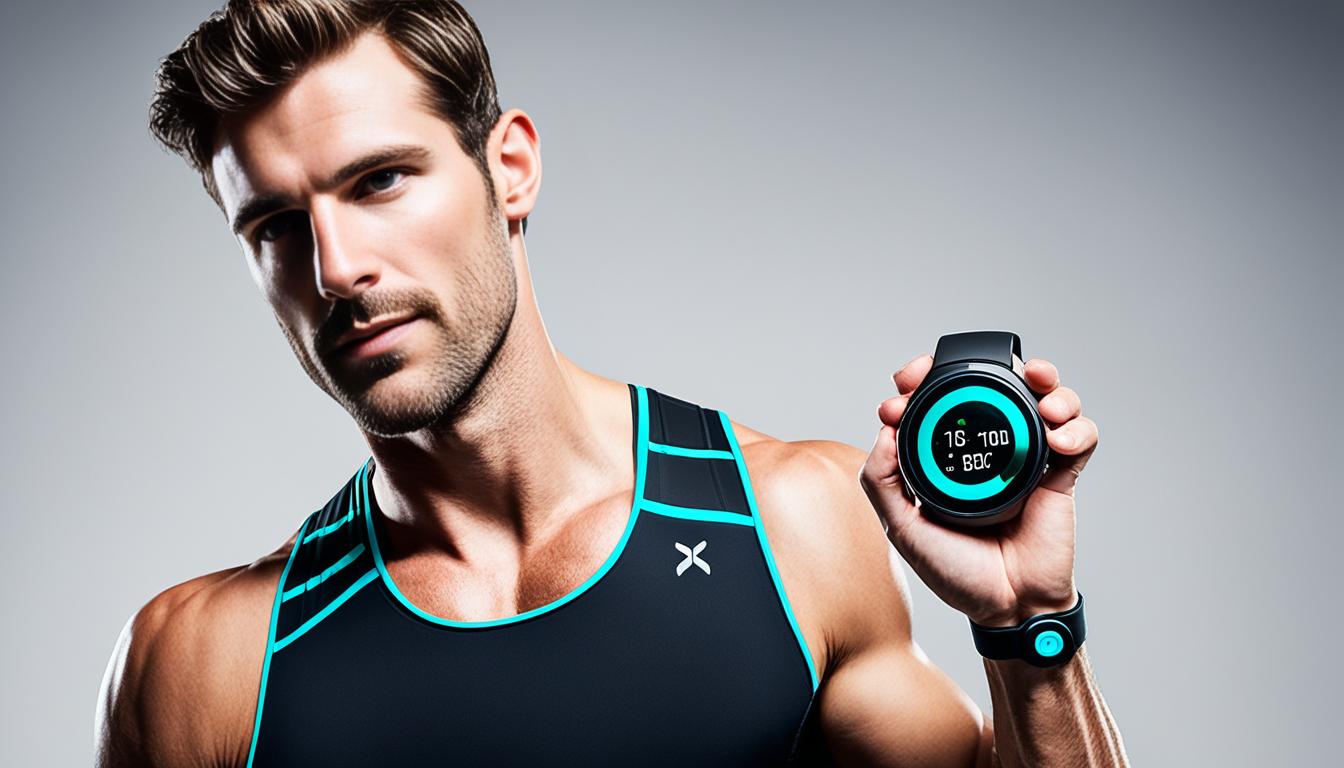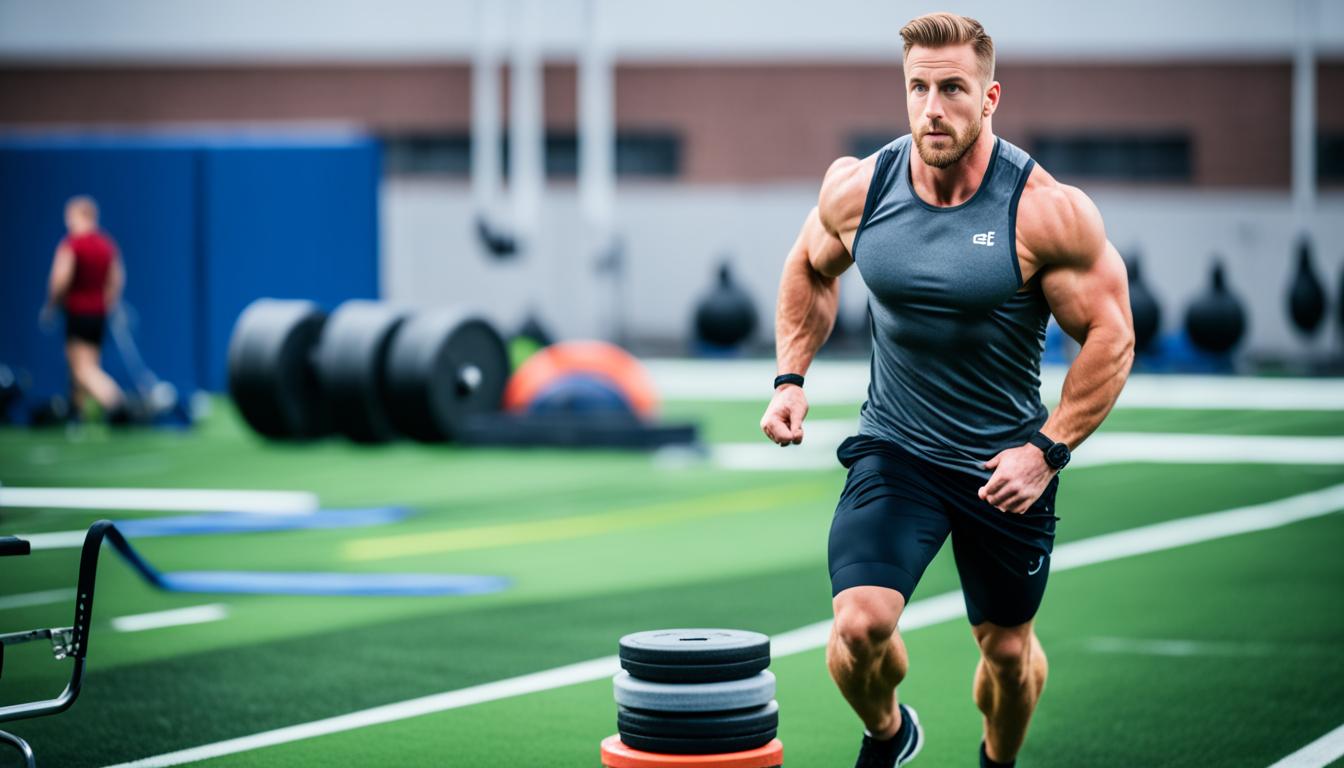Achieving peak performance in sports requires a strategic approach to training. Whether you’re an elite athlete or a weekend warrior, improving your athletic performance can help you reach new heights and attain your goals. In this section, we will explore effective methodologies and techniques that can optimize your athletic potential, helping you unlock your peak performance.
Key Takeaways:
- Implementing periodization can help tailor your training cycles for optimal results.
- High-Intensity Interval Training (HIIT) can maximize your efficiency in cardiovascular fitness.
- Strength and conditioning exercises are essential for building a strong foundation.
- Revolutionary technologies such as wearable devices and virtual reality can enhance your performance.
- Embracing biohacking and integrative medicine can optimize your overall health and athletic performance.
Periodization: Tailoring Training Cycles for Success
Periodization is a fundamental concept in sports training that plays a crucial role in optimizing athletic performance. By dividing the training year into distinct phases, athletes can strategically plan their workouts, ensuring they reach their peak potential when it matters the most.
During each phase, specific training objectives are targeted, leading to progressive improvements and preventing overtraining. Let’s take a closer look at the different phases of periodization and how they contribute to sustained peak performance:
1. Base Phase:
In the base phase, athletes focus on developing a solid foundation of fitness. This phase emphasizes low to moderate intensity training, aiming to enhance aerobic capacity, muscular endurance, and overall conditioning. Workouts primarily consist of longer, steady-state runs or rides, as well as strength training exercises that build functional strength.

2. Build Phase:
Once a foundation is established, athletes progress to the build phase, where training intensity and volume increase. This phase is designed to improve strength, power, and speed, focusing on sport-specific drills and exercises. Athletes engage in high-intensity interval training (HIIT) sessions, strength training with heavier loads, and skill-specific drills to simulate competition conditions.
3. Peak Phase:
The peak phase is the culmination of the training cycle when athletes aim to reach their highest level of performance. Workouts during this phase are highly specialized and intense, focusing on fine-tuning skills, refining technique, and honing mental preparedness. The duration of intense workouts is reduced while maintaining intensity, allowing the body to fully recover and optimize performance for upcoming competitions or events.
By following a periodization plan, athletes can strategically optimize their training to ensure they achieve their peak performance when it matters most. Whether it’s endurance, strength, power, or speed, each phase of periodization contributes to a well-rounded and successful athletic performance. Remember, success doesn’t happen overnight; consistent adherence to the periodization plan is key to achieving long-term goals.
“Periodization enables athletes to structure their training effectively, resulting in improved performance and reduced risk of injury. It’s like a roadmap guiding them to their peak.”
High-Intensity Interval Training (HIIT): Maximizing Efficiency
When it comes to optimizing your athletic performance, High-Intensity Interval Training (HIIT) is a game-changer. This training methodology combines short bursts of intense activity with brief rest periods, creating a powerful workout that maximizes efficiency.
HIIT has gained popularity among athletes and fitness enthusiasts due to its ability to deliver impressive results in a shorter period of time compared to traditional cardio workouts. By pushing your body to its limits during intense intervals, HIIT helps improve cardiovascular fitness, boost metabolism, and burn calories long after your workout is over.
Research has shown that HIIT can enhance both aerobic and anaerobic fitness levels, making it a versatile training method for athletes in various sports disciplines. Whether you’re a runner looking to improve your speed and endurance or a team sport athlete striving for explosive power, incorporating HIIT into your training regimen can take your performance to new heights.
Not only does HIIT provide cardiovascular benefits, but it also challenges different energy systems in the body, leading to improved overall fitness. The short, high-intensity bursts during the workout stimulate adaptations in the cardiovascular system, resulting in increased heart strength, improved lung capacity, and better oxygen utilization.
To incorporate HIIT into your training routine, start by selecting exercises that target the specific muscle groups relevant to your sport. Design a workout that includes a combination of exercises such as sprints, plyometrics, burpees, and kettlebell swings, ensuring you alternate between high-intensity effort and active recovery periods.
Including HIIT sessions in your training schedule not only saves time but also allows flexibility. Whether you’re short on time or looking to add variety to your workouts, HIIT can be adapted to suit your needs. It can be performed at the gym, on a track, or even at home with minimal equipment.
HIIT maximizes both your time and effort, making it an efficient training method that pushes you to your limits and helps you achieve your fitness goals.
The Science Behind HIIT
HIIT works by challenging the body’s energy systems and causing metabolic adaptations. When you perform high-intensity exercises, such as sprinting or jumping, your body relies heavily on anaerobic metabolism, utilizing stored energy sources for quick bursts of power.
During the recovery periods in HIIT, your body switches to aerobic metabolism to replenish energy stores and clear metabolic byproducts like lactic acid. This constant switching between energy systems not only improves your cardiovascular capacity but also enhances your body’s efficiency in utilizing both anaerobic and aerobic pathways.
Benefits of HIIT for Cardiovascular Fitness
HIIT has been found to have numerous benefits for cardiovascular fitness. Studies have shown that HIIT can increase VO2 max, a measure of the body’s ability to use oxygen during exercise, which is a key indicator of cardiovascular fitness.
Additionally, HIIT has been shown to improve other markers of cardiovascular health, such as blood pressure, cholesterol levels, and insulin sensitivity. By incorporating HIIT into your training routine, you can not only improve your athletic performance but also enhance your overall cardiovascular health.
With the time-efficient and effective nature of HIIT, athletes can optimize their training sessions to target specific fitness goals while maximizing efficiency. Whether you’re an elite athlete striving for peak performance or an individual looking to improve your cardiovascular fitness, HIIT can help you unlock your full potential.
Strength and Conditioning: Building the Foundation
In order to excel in your athletic endeavors, it is crucial to establish a solid foundation through strength and conditioning. These two components go hand in hand, providing the groundwork for optimal performance. By incorporating resistance training, functional movements, and conditioning exercises, you can unlock your true athletic potential.
Resistance training forms the core of strength and conditioning programs. It involves utilizing various techniques and equipment to build muscle strength and endurance. By challenging your body with progressive resistance, you stimulate muscle growth and improve overall power and stability.
Functional movements, on the other hand, focus on exercises that mimic real-life activities and sports-specific actions. These movements enhance your coordination, balance, and mobility, translating into more efficient and effective performance in your chosen sport. It’s about training your body to move in ways that are directly applicable to your athletic pursuits.
Conditioning exercises play a vital role in developing the cardiovascular endurance required for sustained athletic performance. Whether it’s running, cycling, or circuit training, incorporating cardio exercises into your routine improves your body’s ability to deliver oxygen and energy to working muscles, allowing you to perform at a high level for extended periods of time.
When designing your personalized strength and conditioning program, it is essential to target specific muscle groups that are crucial for your sport. By identifying and focusing on the muscles directly involved in your movements, you can optimize your training and improve performance in those areas. Consulting with a certified strength and conditioning specialist can provide valuable guidance in tailoring your program to meet your specific needs.
In addition to enhancing performance, strength and conditioning also play a vital role in injury prevention. A well-rounded training program can fortify your body against common sports-related injuries by improving joint stability, muscular balance, and proprioception. By addressing muscular imbalances and weaknesses, you create a solid foundation that helps reduce the risk of injuries, allowing you to perform at your best without interruptions.
Overall, strength and conditioning are essential components for any athlete looking to reach their full potential. By incorporating resistance training, functional movements, and conditioning exercises, you can build a solid foundation for optimal performance while reducing the risk of injuries. Take the time to design a personalized program that aligns with your goals and consult with a professional if needed. Embrace strength and conditioning as a fundamental part of your athletic journey.

Revolutionary Technology for Optimal Results
In today’s rapidly evolving world of sports training, wearable technology, virtual reality (VR), and artificial intelligence (AI) are redefining the boundaries of performance optimization. These cutting-edge technologies are empowering athletes to push their limits and achieve unprecedented levels of success.
Monitoring Performance with Wearable Technology
Wearable technology has become an integral part of modern sports training. These innovative devices, such as fitness trackers and smartwatches, provide athletes with real-time data on various performance metrics, including heart rate, distance covered, and calories burned. By monitoring these key indicators, athletes can make data-driven decisions to optimize their training regimens, track progress, and prevent injuries.

Enhancing Skills and Mental Preparedness through Virtual Reality (VR)
Virtual reality (VR) has emerged as a game-changer in sports training, offering athletes immersive experiences to sharpen their skills and enhance mental preparedness. By simulating real-world environments and high-pressure scenarios, VR enables athletes to visualize and practice their performance in a controlled setting. From improving reaction times in team sports to fine-tuning technique in individual disciplines, VR unlocks new dimensions of training possibilities.
The Power of Artificial Intelligence (AI) in Performance Analysis
Artificial intelligence (AI) algorithms have revolutionized performance analysis by analyzing vast amounts of data and providing athletes with valuable insights. Advanced AI systems can identify patterns, evaluate technique, and pinpoint areas for improvement. Coaches and athletes can harness AI to create personalized training programs tailored to individual strengths, weaknesses, and goals. Through real-time feedback and objective analysis, AI maximizes efficiency and accelerates performance gains.
Revolutionary technologies such as wearable technology, virtual reality (VR), and artificial intelligence (AI) have transformed sports training, unlocking untapped potential and pushing the boundaries of what is possible. By incorporating these cutting-edge tools into their training routines, athletes can optimize their performance, achieve peak results, and embark on an extraordinary journey of athletic excellence.
Conclusion
Unlocking your peak athletic performance goes beyond just physical training. Embracing biohacking and integrative medicine can be the key to reaching your full potential. By addressing the root causes of imbalances within your body and promoting overall well-being, you can optimize your health and enhance your athletic abilities.
One crucial aspect of biohacking is optimizing sleep and recovery. Quality rest is essential for muscle repair, hormone regulation, and mental clarity. Integrating strategies such as creating a sleep routine, using smart sleep trackers, and practicing relaxation techniques can help you achieve better sleep and wake up refreshed for optimal performance.
Enhancing metabolism and energy levels is another vital component of biohacking for athletes. By understanding your body’s unique metabolic profile, you can tailor your nutrition and exercise routines to maximize energy production. Combined with functional movement exercises and targeted nutrition plans, you can fuel your body efficiently and sustain optimal performance.
Furthermore, biohacking embraces the use of therapeutic natural supplements and innovative technology to support your athletic journey. From adaptogenic herbs to boost endurance and resilience to wearable devices that track and analyze your performance data, these tools can provide valuable insights and support in your quest for athletic greatness.
FAQ
What is periodization in sports training?
Periodization is a training concept that involves dividing the training year into distinct phases. Each phase has a specific focus and purpose, contributing to sustained peak performance. It allows athletes to strategically plan their training to optimize performance and prevent burnout.
What are the benefits of high-intensity interval training (HIIT) for athletes?
HIIT is a training methodology that combines short bursts of intense activity with brief rest periods. It is known for its efficiency in improving cardiovascular fitness, increasing metabolism, and enhancing overall athletic performance. HIIT can be customized to suit individual sport-specific training needs, making it a popular choice among athletes.
Why is strength and conditioning important for athletic performance?
Strength and conditioning play a crucial role in enhancing athletic performance and preventing injuries. By incorporating resistance training, functional movements, and conditioning exercises, athletes can improve muscular strength, power, and endurance. It also helps in developing sport-specific skills, fortifying the body against injuries, and optimizing overall physical fitness.
What are some cutting-edge technologies used for sports training?
The world of sports training has been revolutionized by cutting-edge technologies. Wearable technology allows athletes to monitor their performance, track vital metrics, and make data-driven decisions. Virtual reality enhances skill development and mental preparedness by replicating real-life scenarios. Artificial intelligence offers performance analysis and personalized training programs based on individual data and performance patterns.
How do biohacking and integrative medicine contribute to peak athletic performance?
Biohacking and integrative medicine take a holistic approach to optimize peak athletic performance. By addressing root causes and promoting balance within the body, athletes can enhance their metabolism, energy levels, and overall health. Optimizing sleep and recovery, utilizing therapeutic natural supplements, and incorporating innovative technologies can help athletes unlock their full potential.
Source Links
- https://medium.com/@Shawpeters/unlocking-peak-performance-training-strategies-for-athletes-993b8c3eb841
- https://utilitiesone.com/enhancing-athletic-performance-engineering-strength-and-conditioning
- https://www.linkedin.com/pulse/unlocking-athletic-peak-performance-power-biohacking-integrative


